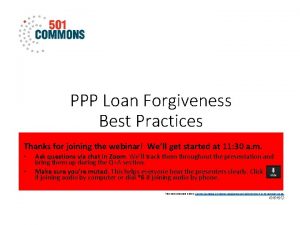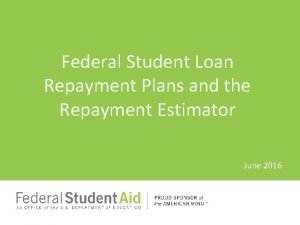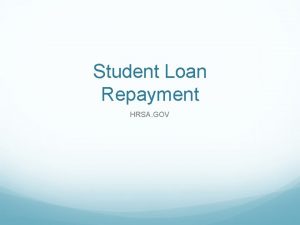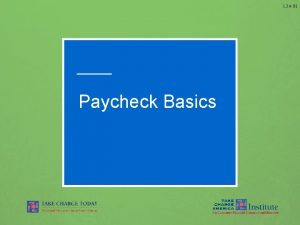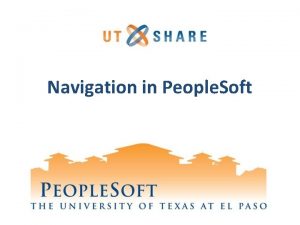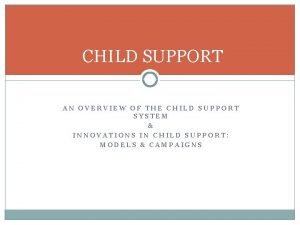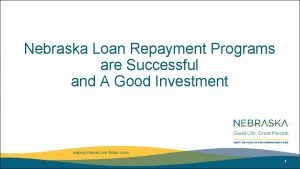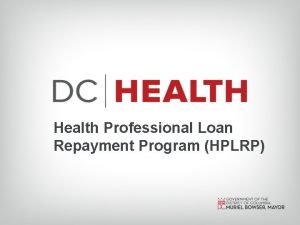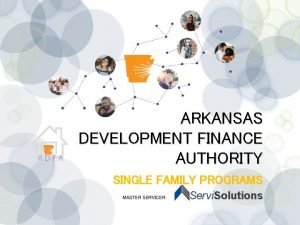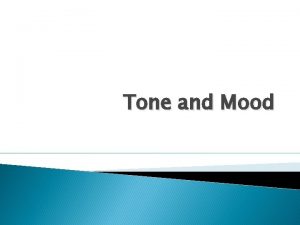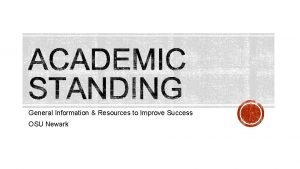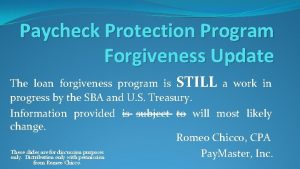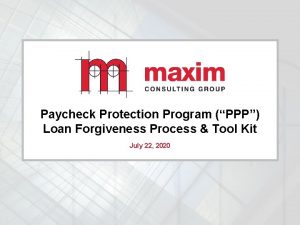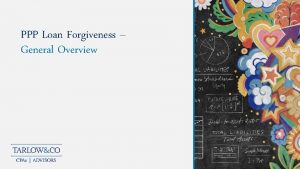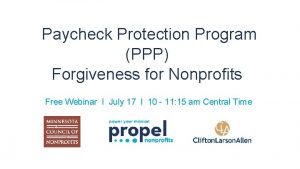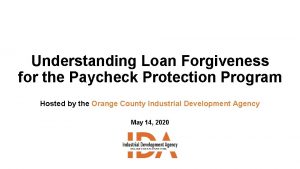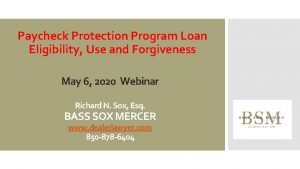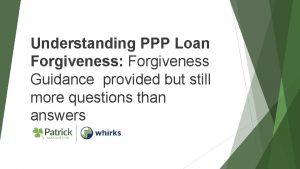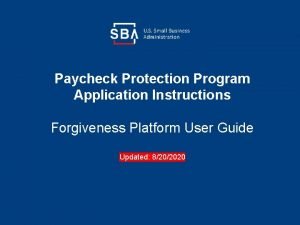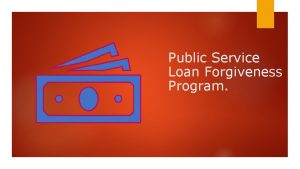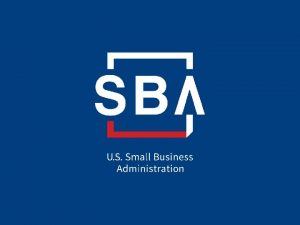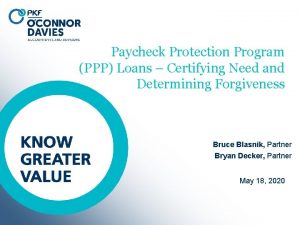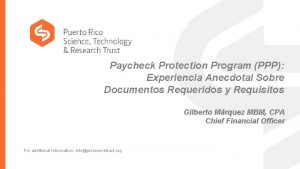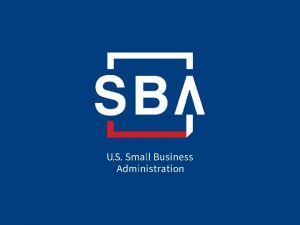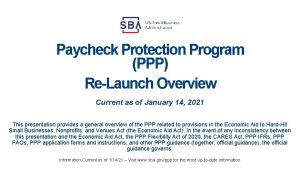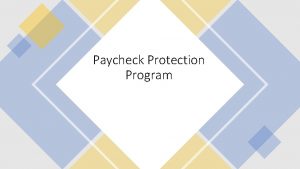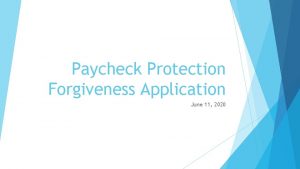Paycheck Protection Program PPP Loan Forgiveness Rules Agenda






























- Slides: 30

Paycheck Protection Program (PPP): Loan Forgiveness Rules

Agenda • Expected Forgiveness Amount • Limits on Loan Forgiveness • Full Time Equivalent Employees • Wage and Salary Reductions • SBA 75%/25% Rule • Overhead rate implications

Expected Forgiveness Amount • Defined: Amounts of the PPP loan that were used during the eight weeks following receipt of the proceeds (covered period) for: • Payroll costs, and to pay the following obligations in effect on Feb. 15, 2020 for mortgage interest, other debt interest, rent, and utilities

Data Required • Gross payroll, that includes wages, bonuses, tips, PTO or other paid leave, severance (limited to $15, 385) ($100, 000 *8/52) but does not include paid leave required by FFCRA • Health care costs for employees • Contributions to qualified retirement plans • Payments of state/local taxes based on compensation • Self-employment income of partners or owners operating as a self employed individual (not payments to non-owner independent contractors) • Amount paid on leases, mortgages and utility contracts that predate Feb. 15, 2020 and are business expenses (shown on 2019 Form 1040 Sch C for sole proprietorships)

Payroll Cost for Forgiveness • Same definitions as for loan approval • Health care cost guidance needed, for FFCRA purposes leeway given to the employer • Employer retirement plan contributions including 401(k) matches, profits sharing and defined benefit contributions

Open Questions on Expected Forgiveness Amount • Must qualified retirement plan contributions during the 8 -week covered period be converted to a monthly amount? • For loan approval an annual contribution was part of the 12 month average, which essentially converted the annual contribution to a monthly amount • Current guidance does not require one time contributions during the covered period to be pro-rated to match the 8 -week period, it would not be unreasonably for future guidance to require such allocation • What interest is included? • Statute includes debt on real and personal property but not capital leases. No current disallowance of mortgages or rental payments to related parties, but future guidance may change that position.

Open Questions on Expected Forgiveness Amount • Must “utilities” be provided by a public utility company, an organization that maintains the infrastructure for a public service and are subject to regulation? • If no, can internet, cell phone, TV cable, trash collection, etc. be counted in addition to electricity, water, gas and sewer? • Does this need to be answered, given the limitation on forgiveness of non-payroll cost? Maybe to prove funds were spent only as allowed even if not forgiven. • “Costs incurred and payments made” during the covered period are eligible forgiveness. How should “costs incurred” be applied?

Reductions of Expected Forgiveness Amounts • Statutory reduction if • The FTE count during the covered period is fewer than the pre. COVID-19 levels • FTE count during the covered period can be increased by rehiring before June 30, 2020 the number of FTEs terminated February 15, 2020 through April 26, 2020 • For employees with < $100, 000 of 2019 compensation, the wage and salary payments during the covered period are less than 75% of the wage and salary amounts for the next earliest full calendar quarter (Q 1 -2020 for PPP loan received in Q 2 of 2020) • Wages actually paid to such employees during the covered period can be increased by payments made before June 30, 2020 to re-hired employees who were terminated February 15, 2020 through April 26, 2020

FTE Definition - Why IRC 4980 H? • Why are we applying IRC 4980 H when Section Sec. 1106 of the Act does not define the term “full-time equivalent employee” • Application of “rules of statutory construction” –When a statute is ambiguous, see if the same terms were used anywhere else in the same statute and use that same meaning to clear up any ambiguity assuming if Congress said “full-time equivalent employee” in one part of a statute, then they used the same term again in another part of the statute, they intended the same meaning in both places, unless they clearly said differently. • While FTE for loan forgiveness is not clear, we interpret “full time equivalent employee” in Section 1106 to mean FTE under 4980 H, since they used the 4980 H definition of FTE in Section 2302 for the employee retention credit, unless and until SBA says something different

IRC 4980 H Principals for FTE Calculations • A full-time employee is someone who normally averages at least 30 hours per week or 130 hours per month • Hours for bi-weekly, semi-monthly or annual pay periods are not provided, but PPP loan forgiveness requires FTEs be determined for each payroll period • Pending future guidance, we have extrapolated from the 4980 H guidance the expected hours for a full-time employee where the pay periods are bi-weekly, semimonthly or annual • Any one hired as full-time or normally averaging the hours for the pay period to be considered full-time is treated as one FTE • All variable or part time hours worked by employees (not to exceed the full time level) are summed and then divided by the full time hour level for the applicable pay period

Which Employees to Count in FTE Calculations • Count the employees for the employer as used for the PPP • Affiliated groups • If NAICS Code begins with 72 the individual locations used for the PPP application • Member of affiliated groups that include NAICS code of 72, all members except the NAICS code 72 • Employees of the Employer • Those who receive wages under the employer’s EIN(s) • Those who render services but are paid under a different EIN such as a professional employer organization or other similar arrangement • Other arrangements might include a payroll trustee agreement or a management companies that pay workers under its EIN but charges back the payroll cost to its customers

What Information is Needed for FTE Calculations? • Data currently available • For February 15, 2019 -June 30, 2019 (the 2019 comparison period) • Payroll calendar during that time frame • Number of full-time employees for each pay period during that time frame • Total variable hours by all non full-time employees for each pay period during that time frame • For January 1, 2020 -February 29, 2020 (the 2020 comparison period) • The same data as above • For February 15, 2020 through April 26, 2020 which is 30 days after enactment (the rehire eligibility period) • The same data as above

What Information is Needed for FTE Calculations? • Future data once the loan disbursement date is know • For the covered period (date of loan –eight weeks later) • The same data as above • The FTE increases between April 26 and June 30, 2020 • Rehired employees are treated as being employed for the entire covered period and eliminates the impact of averaging

Open Questions on FTE Calculations • How do the rehire provisions apply? • Does it require that the identical employee be re-hired? • We think not, but guidance is needed on how to count FTE rehires prior to June 30, 2020 who are already included in the average FTE for the covered period

What Information is Needed for Wage and Salary Calculations • The wages paid to all employees whose annualized wages does not exceed $100, 000 during the calendar quarter prior to the calendar quarter in which the first PPP loan disbursement received (Q-1 of 2020 for PPP loans received in Q 2 of 2020. • This is the “Protected Class” • The wages paid to the “Protected Class” during the covered period (the 8 weeks post closing).

Reductions of Expected Forgiveness Amounts • No reduction if all proceeds are used forgivable purposes and employee headcount and compensation levels are maintained • Supports DOL’s requirement that at least 75% of loan forgiveness be payroll costs • 8 -week covered period is 56 days while the loan was based on 76 days (2. 5 mos. ), therefore a constant payroll costs would result in approx. 75% of the loan proceeds being spent on payroll costs

Preliminary Results to be Revised Based on Future Guidance – Bank Makes Final Determination 1. Calculate expected forgiveness amount 2. Calculate FTE reduction 3. Calculate wage and salary reduction 4. Subtract item 2 and 3 from item 1 5. Calculate the payroll cost during the covered period 6. Divide item 5 by item 4 7. If the result in item 6 is 75% or greater = Success!!! 8. If the result in item 6 is less than 75% divide the payroll cost in item 5 by 75% to determine the maximum forgiven loan

Are Forgiven Amounts Taxable Income IRS Notice 2020 -32 • Specifically, this notice clarifies that no deduction is allowed under the Internal Revenue Code (Code) for an expense that is otherwise deductible if the payment of the expense results in forgiveness of a covered loan pursuant to section 1106(b) of the Coronavirus Aid, Relief, and Economic Security Act (CARES Act), Public Law 116 -136, 134 Stat. 281, 28693 (March 27, 2020) and the income associated with the forgiveness is excluded from gross income for purposes of the Code pursuant to section 1106(i) of the CARES Act

Should I Repay the Loan in Full? 31. Question: Do businesses owned by large companies with adequate sources of liquidity to support the business’s ongoing operations qualify for a PPP loan? Answer: In addition to reviewing applicable affiliation rules to determine eligibility, all borrowers must assess their economic need for a PPP loan under the standard established by the CARES Act and the PPP regulations at the time of the loan application. Although the CARES Act suspends the ordinary requirement that borrowers must be unable to obtain credit elsewhere (as defined in section 3(h) of the Small Business Act), borrowers still must certify in good faith that their PPP loan request is necessary. Specifically, before submitting a PPP application, all borrowers should review carefully the required certification that “current economic uncertainty makes this loan request necessary to support the ongoing operations of the Applicant. ” Borrowers must make this certification in good faith, taking into account their current business activity and their ability to access other sources of liquidity sufficient to support their ongoing operations in a manner that is not significantly detrimental to the business. For example, it is unlikely that a public company with substantial market value and access to capital markets will be able to make the required certification in good faith, and such a company should be prepared to demonstrate to SBA, upon request, the basis for its certification. • Lenders may rely on a borrower’s certification regarding the necessity of the loan request. Any borrower that applied for a PPP loan prior to the issuance of this guidance and repays the loan in full by May 7, 2020 will be deemed by SBA to have made the required certification in good faith.

Should I Repay the Loan in Full? 37. Question: Do businesses owned by private companies with adequate sources of liquidity to support the business’s ongoing operations qualify for a PPP loan? Answer: See response to FAQ #31.

Should I Repay the Loan in Full? 39. Question: Will SBA review individual PPP loan files? Answer: Yes. In FAQ #31, SBA reminded all borrowers of an important certification required to obtain a PPP loan. To further ensure PPP loans are limited to eligible borrowers in need, the SBA has decided, in consultation with the Department of the Treasury, that it will review all loans in excess of $2 million, in addition to other loans as appropriate, following the lender’s submission of the borrower’s loan forgiveness application. Additional guidance implementing this procedure will be forthcoming.

Should I Repay the Loan in Full? • 43. Question: FAQ #31 reminded borrowers to review carefully the required certification on the Borrower Application Form that “[c]urrent economic uncertainty makes this loan request necessary to support the ongoing operations of the Applicant. ” SBA guidance and regulations provide that any borrower who applied for a PPP loan prior to April 24, 2020 and repays the loan in full by May 7, 2020 will be deemed by SBA to have made the required certification in good faith. Is it possible for a borrower to obtain an extension of the May 7, 2020 repayment date? • Answer: SBA is extending the repayment date for this safe harbor to May 14, 2020. Borrowers do not need to apply for this extension. This extension will be promptly implemented through a revision to the SBA’s interim final rule providing the safe harbor. SBA intends to provide additional guidance on how it will review the certification prior to May 14, 2020.

Should I Repay the Loan in Full? • 46. Question: How will SBA review borrowers’ required good-faith certification concerning the necessity of their loan request? • Answer: When submitting a PPP application, all borrowers must certify in good faith that “[c]urrent economic uncertainty makes this loan request necessary to support the ongoing operations of the Applicant. ” SBA, in consultation with the Department of the Treasury, has determined that the following safe harbor will apply to SBA’s review of PPP loans with respect to this issue: Any borrower that, together with its affiliates, 20 received PPP loans with an original principal amount of less than $2 million will be deemed to have made the required certification concerning the necessity of the loan request in good faith. • 20 For purposes of this safe harbor, a borrower must include its affiliates to the extent required under the interim final rule on affiliates, 85 FR 20817 (April 15, 2020).

Should I Repay the Loan in Full? • 46. Question: How will SBA review borrowers’ required good-faith certification concerning the necessity of their loan request? • Answer: Continued • SBA has determined that this safe harbor is appropriate because borrowers with loans below this threshold are generally less likely to have had access to adequate sources of liquidity in the current economic environment than borrowers that obtained larger loans. This safe harbor will also promote economic certainty as PPP borrowers with more limited resources endeavor to retain and rehire employees. In addition, given the large volume of PPP loans, this approach will enable SBA to conserve its finite audit resources and focus its reviews on larger loans, where the compliance effort may yield higher returns.

Should I Repay the Loan in Full? • 46. Question: How will SBA review borrowers’ required good-faith certification concerning the necessity of their loan request? • Answer: Continued • Importantly, borrowers with loans greater than $2 million that do not satisfy this safe harbor may still have an adequate basis for making the required good-faith certification, based on their individual circumstances in light of the language of the certification and SBA guidance. SBA has previously stated that all PPP loans in excess of $2 million, and other PPP loans as appropriate, will be subject to review by SBA for compliance with program requirements set forth in the PPP Interim Final Rules and in the Borrower Application Form. If SBA determines in the course of its review that a borrower lacked an adequate basis for the required certification concerning the necessity of the loan request, SBA will seek repayment of the outstanding PPP loan balance and will inform the lender that the borrower is not eligible for loan forgiveness. If the borrower repays the loan after receiving notification from SBA, SBA will not pursue administrative enforcement or referrals to other agencies based on its determination with respect to the certification concerning necessity of the loan request. SBA’s determination concerning the certification regarding the necessity of the loan request will not affect SBA’s loan guarantee. 21 • 21 Question 46 published May 13, 2020.

Overhead Rate Implications • Guidance from Defense Pricing and Contracting Implementation Guidance for Section 3610 of the Coronavirus Aid, Relief, and Economic Security (CARES) Act Frequently Asked Questions Issues 4/17/20: • States “Accordingly, to the extent that PPP credits are allocable to costs allowed under a contract, the Government should receive a credit or a reduction in billing for any PPP loans or loan payments, regardless of whether the PPP loan is forgiven. ” • Stating that even if the loan is not forgiven, costs must be reduced. • FHWA (Federal Highway Administration) and AASHTO are not required to follow the Defense Pricing guidelines.

Overhead Rate Implications • It is expected that there are two possible scenarios for the loan forgiveness under FAR: • The DOT’s will require that an Other Direct Credit be provided to them via the billing system for the amount of the loan forgiveness • The cost items that related to the loan forgiveness will be credited to each specific cost objective. • The real question then becomes what happens to labor. • Some believe the labor piece should hit all indirect labor, however we believe that is counter-intuitive to the spirit of the law • We are suggesting, and other A/E Professional Consultants agree, that the credit should be allocated over Direct Labor and Indirect Labor based on the Utilization of the Entity for the 8 week period that the loan was in place (but the credit for DL is “ignored”). • We are currently in discussions with AASHTO Audit Subcommittee members, ACEC National and DOT’s to determine the best route for our clients and ACEC members.

Questions?

Somerset Technology Advisory • Helps clients design a successful remote workforce environment. • Evaluate your current work-from-home environment for security and data protection • Recommend assist in implementing best practices for remote employees • Develop metrics and KPIs to measure remote work productivity • Develop policies and procedures for remote employees

Contact Information Today’s Speakers: Scott Sutton, CPA, CDA, MSA Howard M. Cox, CPA, CMA, CIA Senior Manager 317. 472. 2273 ssutton@somersetcpas. com Principal 317. 472. 2167 hcox@somersetcpas. com Somerset CPAs and Advisors 3925 River Crossing Pkwy, Ste 300 Indianapolis, IN 46240 800. 469. 7206 somersetcpas. com
 Ppp loan forgiveness
Ppp loan forgiveness Nebraska teacher loan forgiveness
Nebraska teacher loan forgiveness Hrsa student loan forgiveness
Hrsa student loan forgiveness Ppp loan list of recipients 2021
Ppp loan list of recipients 2021 Paycheck
Paycheck Paycheck basics
Paycheck basics How much does wanda earn per hour?
How much does wanda earn per hour? Paycheck
Paycheck 3 benefits of paying taxes
3 benefits of paying taxes Jeopardy
Jeopardy Child support arrears forgiveness letter missouri
Child support arrears forgiveness letter missouri Agenda sistemica y agenda institucional
Agenda sistemica y agenda institucional Section 502 guaranteed rural housing loan program
Section 502 guaranteed rural housing loan program Nebraska loan repayment program
Nebraska loan repayment program Dc health professional loan repayment program
Dc health professional loan repayment program Arkansas development finance authority
Arkansas development finance authority Bridge loan
Bridge loan Usda linc training and resource library
Usda linc training and resource library How to explain the tone of a story
How to explain the tone of a story Talk on forgiveness
Talk on forgiveness What forgiveness means
What forgiveness means Great gatsby revision
Great gatsby revision Why does the giver ask jonas for forgiveness?
Why does the giver ask jonas for forgiveness? Oneill
Oneill Grade forgiveness fgcu
Grade forgiveness fgcu Osu!
Osu! Enright forgiveness model
Enright forgiveness model Forgiveness vs reconciliation
Forgiveness vs reconciliation God's forgiveness
God's forgiveness Principles of forgiveness of sin
Principles of forgiveness of sin National board amazonweise yorktimes
National board amazonweise yorktimes
